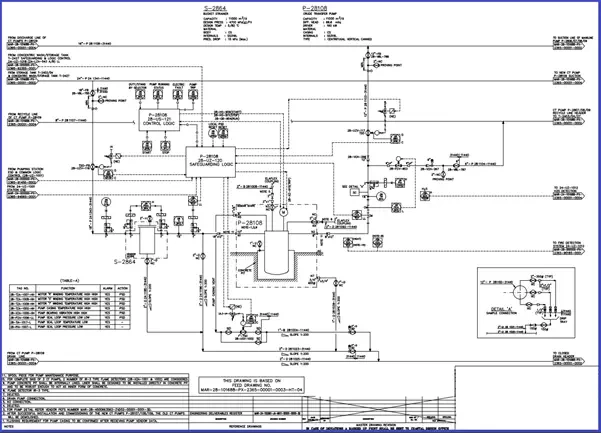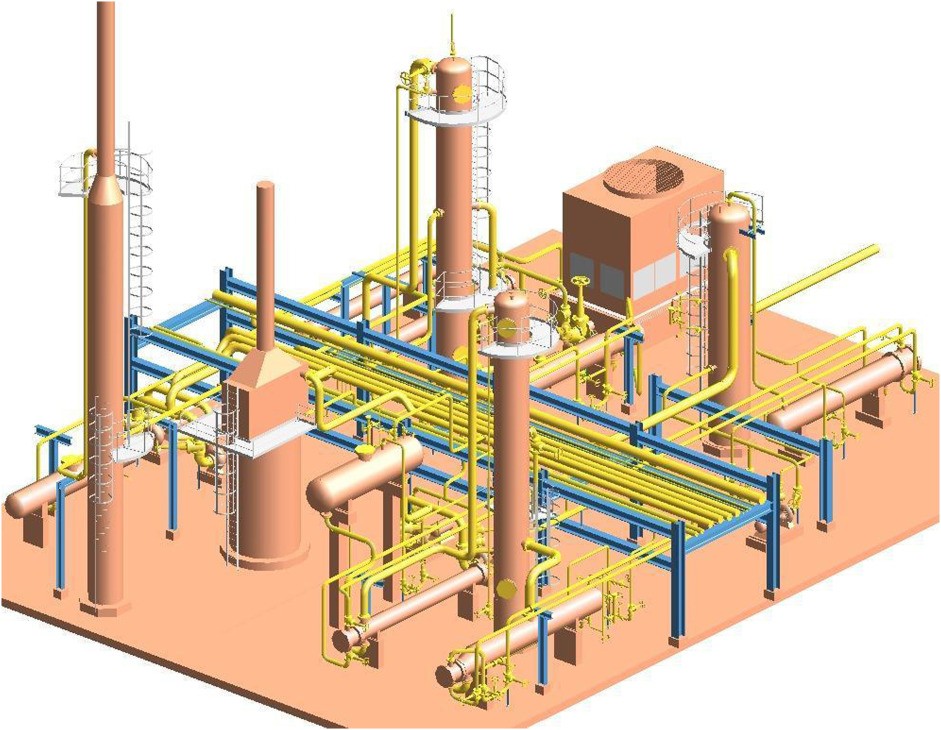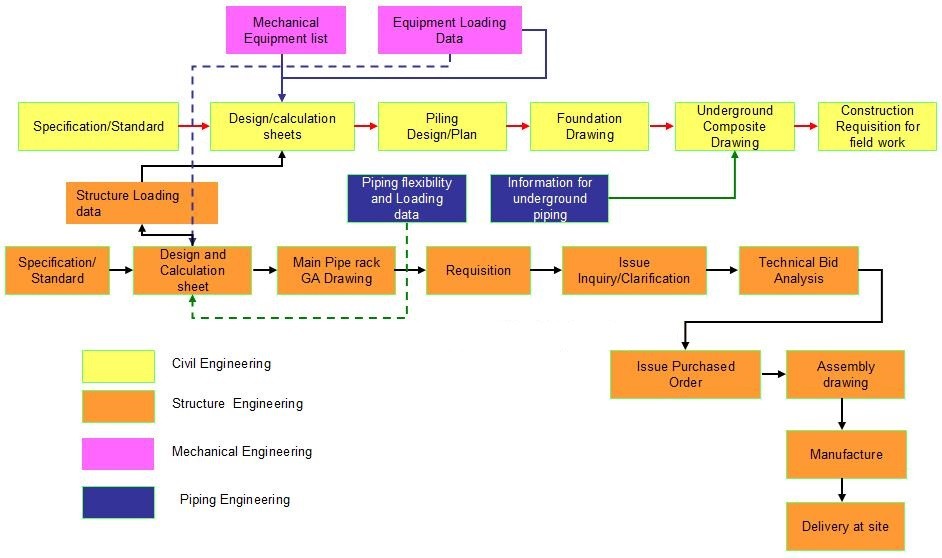Pump Piping Design Considerations
The pump piping design can have an important impact on the operating efficiency
and life expectancy of any pump. Hence, the piping design engineer must
consider the important points while designing the pump piping layout. The
design of a suction and discharge line should be delivered keeping in mind the
operability, maintainability, flexibility, and support requirements of the
piping system.
Poorly
designed pump suction piping can result in the entrapment of air or vapor into
the pump piping and cause cavitation, which displaces liquid within the pump
casing, which results in vibrations, and damages to the pump impeller. Here, we
will learn the design consideration and different layout patterns for pump
piping.
Important
Points to be Considered While Designing Pump Piping
·
The suction pipe size should never be smaller than the pump
suction nozzle. In most cases, it is one size larger than the suction nozzle.
·
The suction line should be as short & straight as
possible.
·
The suction line should be pocket free.
·
All the pump suction lines need to be designed to
accommodate a conical-type temporary strainer for commissioning and testing.
·
The suction and discharge line piping should be supported
independently of the pump foundation.
·
Expansion joints can be used on either the suction or
discharge line side or both as per requirement. However, expansion joints are
the last option and should be used only when it is unavoidable.
·
If expansion joints are used then a pipe anchor must be
given between the expansion joint and pump nozzle to prevent the pressure loads
from getting transferred to the pump nozzle.
·
The suction piping should preferably be horizontal and at a
slope toward the pump suction nozzle from the sump.
·
When the suction piping is in a horizontal plane, we should
provide a minimum of “three to five times the diameter of the suction nozzle”
straight pipe length between the pump suction nozzle and the first elbow or a
flange, valve, tee, or strainer. The reducer may be included in that straight
length.
·
The mating flange of the suction line with the pump suction
nozzle should be of the same rating and material as the pump suction nozzle.
·
The suction pipe velocity should be within 2 m/s, as higher
velocities will cause friction loss.
·
Elbows and tees should be avoided to install adjacent to
the pump suction nozzle as it causes an uneven flow pattern inside the suction
line.
·
If an elbow is needed at the suction line of a double
suction pump, it should be preferred to be in a vertical position. If it is
important for some reason to use a horizontal elbow then it should be a long
radius elbow.
·
Pump piping should be designed with adequate space to
facilitate the removal of the pump for maintenance purposes.
·
Lifting facilities are provided where the weight of the component
exceeds 25 kilograms. So it is required to provide space for mobile equipment
to deliver damage-free maintenance.
·
The Spare pump should be considered while designing the
pump piping as a backup pump is required to deliver continuous production in
case of the main pump maintenance period.
·
The pump piping should have removable spool pieces with
breakup flange if they obstruct the lifting operations.
Fittings
and Components Used in the Pump Suction Line

The
most commonly used piping fittings and components in the suction line are as
follows:
Isolation
Valve
The
isolation valve (mostly gate valve) must be provided on the suction line
upstream side of the strainer to allow its removal during maintenance or to
isolate the complete suction line. It should be located within three meters of
the pump suction nozzle for efficient delivery and it should be convenient for
hand operation. Usually, the size of the isolation valve is the same as the
suction line.
Strainer
Strainers
are used in the suction lines to collect the debris flowing with the fluid
which prevents damaging the internal parts of the pump. Strainers are located
between isolation valves and the reducer or pump nozzle. Temporary strainers
are used at the initial stage after the pump has run successfully for several
days the isolation valve can be closed and a temporary strainer is removed.

The
temporary strainer is always of conical type and installed at the removable
spool. The permanent strainers can be either Y-type, T-type, or bucket type.
They are used as per the line size, fluid nature, and piping layout.
Drain
Low
point drains are provided in the suction line (mostly between strainer and
reducer). It is required during the hydro testing and maintenance of the line
to drain out the fluid completely from the suction line.
Reducer
Due to
the suction line being larger than the pump suction nozzles, reducers
are required to maintain the differences in the line. Reducers should be
installed as close as possible to the nozzle to avoid turbulence inside the
line.
Eccentric
reducers flat side up or flat side top are used in the
horizontal suction line. Eccentric reducer (FSU) prevents vapor from being
trapped and encouraging the phenomenon of cavitation which can further damage the pipe and pump
impeller.
If the horizontal suction line carrying slurry inside then
it is required to provide an eccentric reducer flat side down or flat side
bottom type for smooth flow of slurry.
If the
reducer is installed in the vertical line then it should be a concentric
reducer unless there is a special requirement.
Fittings
and Components Used in the Pump Discharge Line
The
most commonly used piping fittings and components in the discharge line are as
follows:
Reducer
In
most of the cases, a concentric reducer is used in the discharge line and it is
kept near to the discharge nozzle as much as possible. The straight pipe length
between the discharge nozzle and reducer is required to keep a minimum of 5
times the diameter of the discharge nozzle. The reducer length may also be
included in the straight length.
If the
discharge line is in a horizontal plane as in the case of side suction side
discharge pump then the eccentric reducer flat side down can be used for ease
of the support.
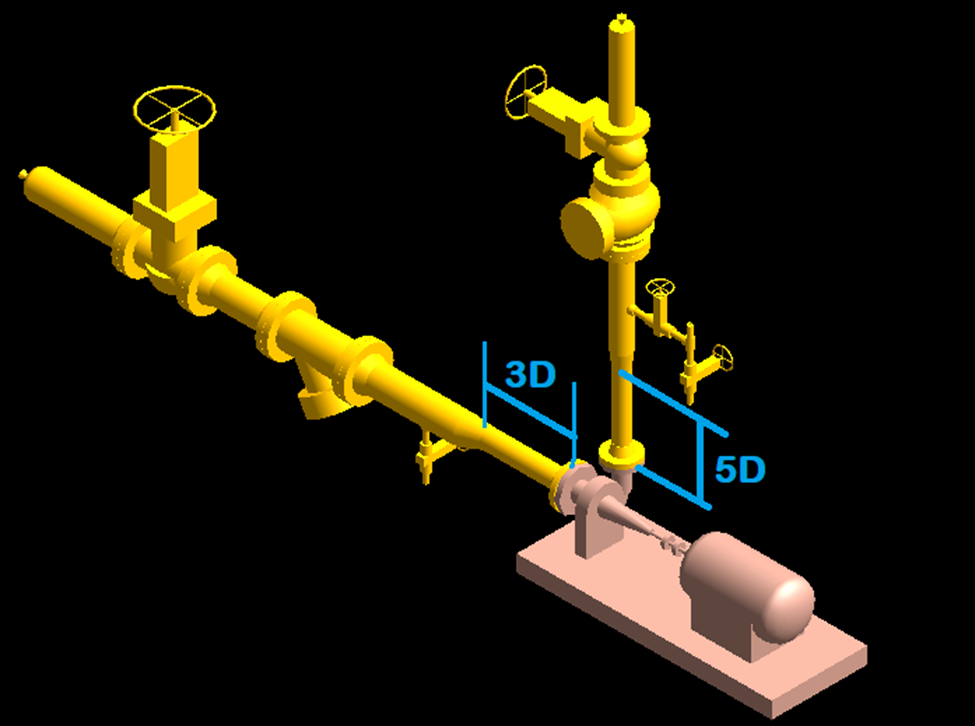
Pressure
Gauge Assembly
The
pressure gauge should be located on the discharge line before the check and
isolation valve to keep eye on discharge pressure. Pressure gauge assembly can
have the drain as well.
Check
Valve
Check
valves are generally installed in the discharge line after the reducer and
pressure gauge assembly to prevent backflow. A check valve is a one-way valve,
in which the flow can run freely one way, but if the flow turns back then the
valve gets close to prevent the line from backflow.
If the
flow turns back and there is no check valve is installed, then the water hammer
can occur. Sometimes water hammer occurs with an intense force and can easily
damage piping components and the pump.
Up-to
1*1/2″ Lift Type Check Valve is used and it can be used in a horizontal and
vertical line as well.
Above
1*1/2″ Swing Type Check Valve is used and it is mostly installed in a
horizontal line. If required up to 6″ swing check valve can be installed in a
vertical line but above 6″ check valve should be installed in a horizontal line
only.
Isolation
Valve
The
isolation valve (mostly gate valve) is installed just after the check valve to
isolate the discharge line and to remove the check valve for maintenance, as
the check valve required regular maintenance. The isolation valve is installed
by keeping in mind the operability due to its frequent usability.
Pump
Location
The
pump location may vary for many reasons. The main goal in setting the location
of the pump is to minimize the length of the suction piping while fulfilling
the piping flexibility requirements and allowable loads that will be subjected
to the pump nozzles. Let’s see below some point for pump location:
·
The common location of pumps in the hydrocarbon industry is
under the pipe rack at grade level. Click here to see the
pipe rack design
·
Pumps should be placed as close as possible to the vessel
or sump and below the vessels in order to fulfill the net-positive suction head
(NPSH) required by the pump.
·
As per the OISD-118, the Pump should be kept outside of the Tank farm
or dyke wall by maintaining the minimum distance as per the stored fluid class.
·
As per OISD-118, the minimum gap between the two pumps
should be 1 meter.
·
Standard pipe rack column spacing is 6 meters, it is
generally found that only a pair of pumps of average size can be arranged
between the two-columns.
·
As per engineering practices, the minimum gap between the
steel structure and discharge piping should be 0.75 meters.
·
The centerline elevation of the pump can be decided based
upon the space required for the strainer maintenance, as per engineering
practices the minimum gap between the suction line and grade level is taken 300
mm. This gap is not fixed it can vary from company to company.

Pump
Piping Support
A
piping layout engineer must be aware of some basic knowledge of stress and pipe
supports to develop a sound pump piping arrangement, so that it will not be
required to redesign by a stress engineer after finding out the piping design
is not stress friendly.
Some
simple rules, if followed, it will enable the designer to deliver stress
friendly pump piping:
·
If the suction line having an elbow, it can be supported
with a dummy leg or trunnion.
·
The discharge line can be supported with the pipe rack
steel structure or it can be supported by hanger or spring support as per the
convenience.
·
If there is a higher amount of vibration in the line then
to release the stress expansion joint can be used, but it should be avoided.
·
If the pumps are located in the poor soil areas, where
differential settlement may occur, the pump foundation can be extended to
support the suction line. This decision can be taken by keeping stress and
civil engineer in the loop.
·
The discharge line should be supported as close as possible
to the elbow, the closeness can be defined as within 5D.
·
If the line is having high pressure and temperature then
adjustable support can be used to provide flexibility.
·
If the valve is too heavy then both sides of the valve
resting support can be provided.
·
If the discharge line is larger than 6″ then after the
reducer line can be kept horizontal so that there will ease to support and
operating of both valves.

By
keeping in mind the above design considerations, different piping arrangements
or layouts can be created, some companies also use the standard pattern, and
from time to time as per new challenges the design gets modified.
 (1).png)
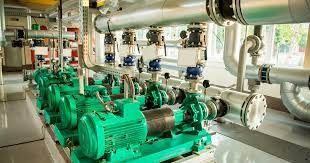
 Prakash K Menon
Prakash K Menon
